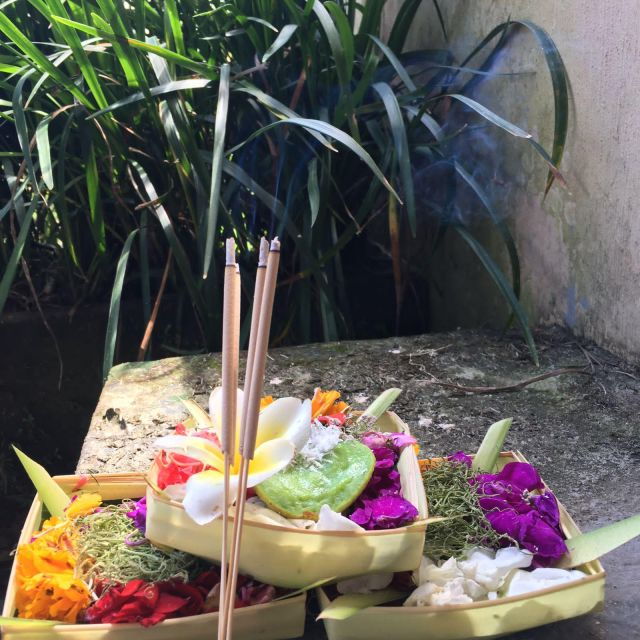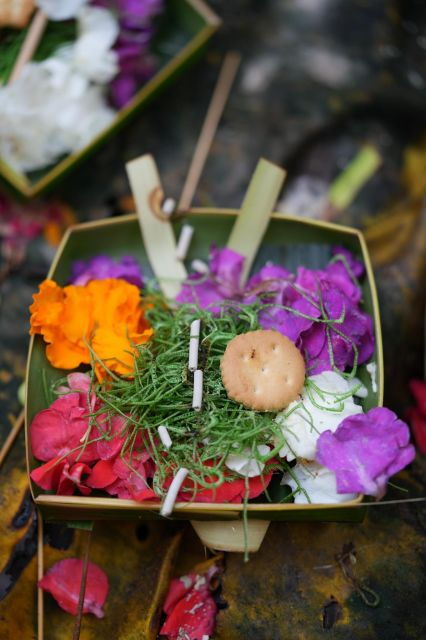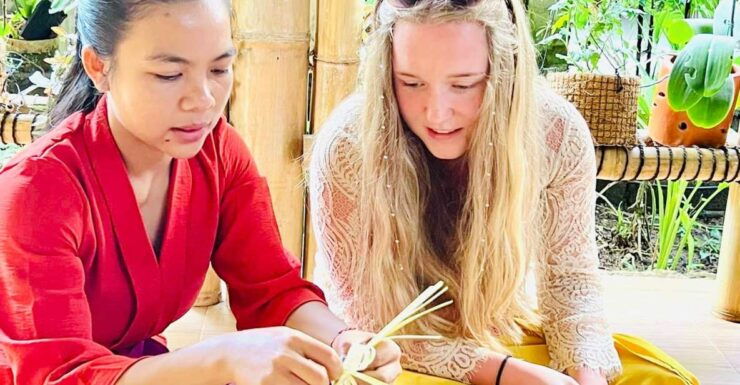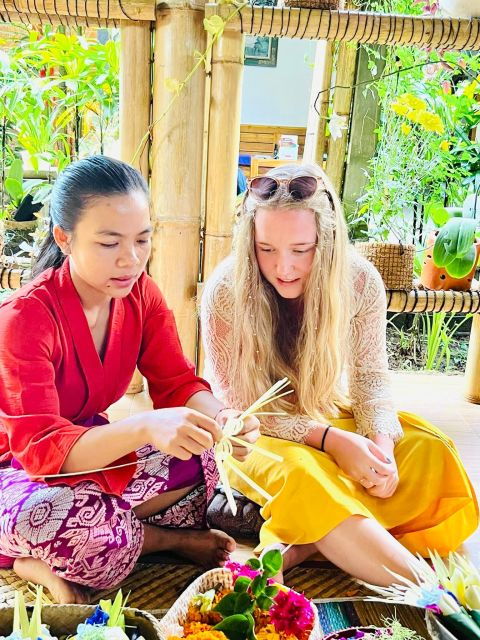Crafting a Canang for daily offerings in Bali requires precision and reverence. The intricate process of assembling this traditional tribute involves delicate arrangements of flowers, incense, holy water, and rice grains, each element carrying deep spiritual symbolism.
As individuals engage in this sacred ritual, they not only express gratitude to the spirits but also align themselves with the profound customs of Balinese culture. The art of making Canang serves as a conduit for spiritual connection and cultural preservation, fostering a sense of unity and harmony.
Intriguingly, the etiquette surrounding Canang creation offers a glimpse into the intricate tapestry of Balinese traditions, emphasizing respect and devotion.
Good To Know

- Canang offerings symbolize gratitude, respect, and spiritual connection.
- Following customs maintains harmony with nature, spirits, and ancestors.
- Making Canang reinforces cultural heritage and unity with the spiritual world.
- The practice promotes balance, interconnectedness, and daily spiritual devotion.
Importance of Canang Offering

The Canang offering holds a significant place in Balinese culture, symbolizing gratitude, blessings, and harmony with the spirits. This traditional Balinese daily offering plays a vital role in fostering a spiritual connection with the divine and ancestral realms.
By making these offerings, individuals demonstrate their respect and devotion to the spirits, seeking blessings and prosperity in return. Through this Balinese tradition, people aim to maintain harmony and balance in their lives, acknowledging the interconnectedness of all beings.
The act of creating and offering Canang is deeply rooted in the belief that it promotes unity with nature, fellow humans, and the spiritual world. Passed down through generations, this practice continues to enrich the cultural tapestry of Bali with its profound spiritual significance.
Find more activities and experiences we've covered in Ubud.
Materials Needed for Making Canang

Gathering essential materials is crucial for crafting a Canang, a traditional Balinese daily offering symbolizing gratitude and harmony. The following table outlines the necessary items for making a Canang:
| Materials | Description | Purpose |
|---|---|---|
| Bamboo basket | Container for the offerings | Holds the components |
| Flowers and leaves | Colorful and fragrant elements | Symbolizes beauty |
| Incense sticks | Aromatic rods used for prayers | Represents spirituality |
| Holy water | Purified water with spiritual significance | Cleanses the offering |
| Rice grains | Staple food item in Balinese culture | Represents sustenance |
These materials are essential for creating a beautiful floral arrangement that honors this cultural tradition.
Steps to Make a Canang

Honoring the tradition of making Canang involves a series of meaningful steps that reflect gratitude and respect in Balinese culture.
Steps to Make a Canang:
Prepare the materials: Gather a bamboo basket, flowers, incense sticks, holy water, and rice grains.
Arrange flowers in the basket: Create an artistic arrangement of flowers and leaves with care and precision.
Enhance spiritual connection: Add incense sticks for a fragrant offering, sprinkle holy water to purify the space, and place rice grains symbolizing sustenance and prosperity.
The process of making Canang isn’t just a daily routine but a spiritual practice that fosters a deep connection with nature and the divine.
More Great Tours NearbySignificance of Canang in Balinese Culture
What role does the daily offering of Canang play in preserving the cultural heritage and spiritual beliefs of the Balinese people?
Canang holds a profound significance in Balinese culture, being an essential daily practice that fosters a deep spiritual connection with the divine and nature.
By offering Canang outside homes and businesses each day, Balinese people uphold the Tri Hita Karana philosophy, promoting unity with nature, fellow humans, and spirits.
This ritual not only enhances their spiritual connection but also symbolizes respect, gratitude, and devotion to the unseen forces that govern their lives.
Passed down through generations, the act of making and offering Canang is a sacred tradition that helps maintain harmony and balance in the community, reinforcing the cultural fabric of Bali.
Canang Etiquette and Customs
Crafted with meticulous care and reverence, Canang offerings in Balinese culture hold significant importance in daily rituals and customs.
Canang Etiquette and Customs:
Canang placement:
- Canangs are placed in specific locations such as family shrines, temples, and entrances to homes or businesses.
Offering disposal:
- It’s crucial to dispose of the offerings properly to avoid disrespect. This involves letting nature take its course, as the organic materials will naturally decompose.
Morning offerings:
- Canangs are traditionally offered in the morning to start the day with gratitude and respect for the spirits. It’s important to avoid stepping on or kicking the offerings to show reverence and appreciation for the ritual.
Common Questions
Are There Specific Colors or Types of Flowers That Are Preferred for Making a Canang Offering?
When making a canang offering, specific flower colors hold symbolic meanings. Traditional Balinese customs often favor red, white, yellow, and black flowers. Each color represents aspects like purity, spirituality, strength, and prosperity, enhancing the ritual’s significance.
What Is the Significance of the Specific Arrangement of the Flowers in the Canang Basket?
The significance of the specific arrangement of flowers in a canang basket lies in its representation of cultural traditions and spiritual beliefs. This arrangement symbolizes respect, devotion, and harmony, embodying the unity with nature, humans, and spirits in Balinese culture.
Can Canang Offerings Be Made for Specific Intentions or Requests, or Are They Always General Expressions of Gratitude?
Canang offerings can be made for specific intentions, beyond general gratitude. Traditional prayers accompany these requests. While preferred colors and specific arrangements hold symbolic meanings, the practice remains a deeply personal and spiritual act.
How Long Does a Typical Canang Offering Last Before It Needs to Be Replaced With a New One?
A typical Canang offering lasts for a day in Balinese culture before needing replacement. Proper care and respect are vital due to the ritualistic practices and cultural beliefs surrounding the frequency of replacement, ensuring the continuation of spiritual connection.
Are There Any Traditional Prayers or Chants That Are Typically Recited While Making or Offering a Canang?
Traditional mantras are recited during the daily rituals of making and offering Canang. This spiritual practice holds great cultural significance in Balinese traditions, enhancing spiritual connections and promoting unity with nature, humans, and spirits, passed down through generations.
The Sum Up
To sum it up, the act of making Canang is a sacred and cherished tradition in Bali, symbolizing gratitude, respect, and spiritual connection.
By carefully crafting these daily offerings with devotion and following customs and etiquette, individuals uphold their cultural heritage and maintain harmony within their community.
The significance of Canang goes beyond a simple gesture of thanks, representing a deep reverence for the spirits, ancestors, and the principles of Tri Hita Karana.
You can check availability for your dates here: More Great Tours NearbyMore Tour Reviews in Ubud
Looking for something different? Other Ubud activities we've written about
- 25 Best Guided Tours In Ubud
- 25 Best Tours In Ubud
- 22 Best Shopping Tours In Ubud
- 20 Best Spa And Hot Springs Experiences In Ubud
- 19 Best Massage And Relaxation Services In Ubud
- 15 Best Historical Tours In Ubud
- 13 Best Dolphin Watching Tours In Ubud
- 25 Best Workshops And Classes In Ubud
- 12 Best 3 Day Tours In Ubud
- 25 Best Snorkeling Experiences In Ubud
- 20 Best Full-Day Tours In Ubud
- Best Boat Tours And Cruises In Ubud
